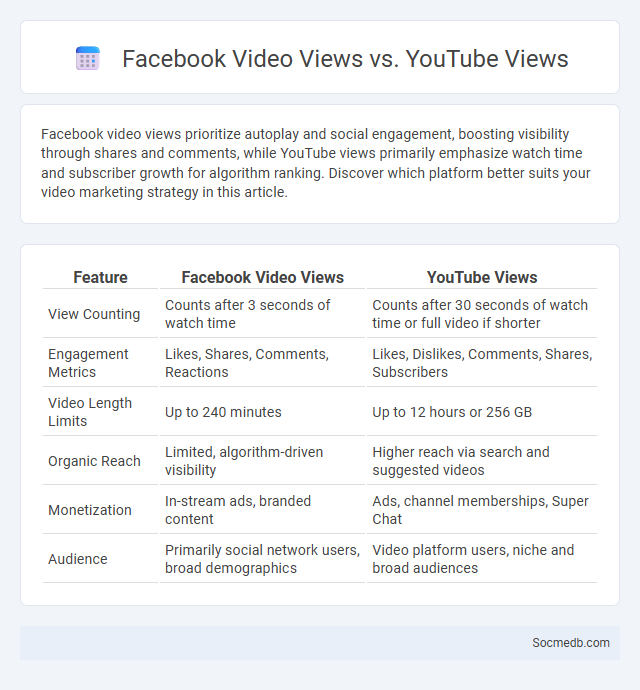
Photo illustration: Facebook Video Views vs YouTube Views
Facebook video views prioritize autoplay and social engagement, boosting visibility through shares and comments, while YouTube views primarily emphasize watch time and subscriber growth for algorithm ranking. Discover which platform better suits your video marketing strategy in this article.
Table of Comparison
| Feature | Facebook Video Views | YouTube Views |
|---|---|---|
| View Counting | Counts after 3 seconds of watch time | Counts after 30 seconds of watch time or full video if shorter |
| Engagement Metrics | Likes, Shares, Comments, Reactions | Likes, Dislikes, Comments, Shares, Subscribers |
| Video Length Limits | Up to 240 minutes | Up to 12 hours or 256 GB |
| Organic Reach | Limited, algorithm-driven visibility | Higher reach via search and suggested videos |
| Monetization | In-stream ads, branded content | Ads, channel memberships, Super Chat |
| Audience | Primarily social network users, broad demographics | Video platform users, niche and broad audiences |
Understanding Video View Metrics on Facebook, YouTube, and Other Platforms
Understanding video view metrics on Facebook, YouTube, and other platforms is crucial for analyzing the performance of your content and optimizing engagement strategies. Facebook tracks metrics like 3-second views and average watch time, while YouTube emphasizes views, watch time, and audience retention to measure video success. Your ability to interpret these platform-specific analytics enables precise targeting and improves content relevance, driving better results across social media campaigns.
Key Differences Between Facebook and YouTube Video Views
Facebook video views are counted after just three seconds, making it easier for videos to accumulate views quickly, while YouTube requires viewers to watch at least 30 seconds or a significant portion of the video for a view to count. YouTube views are often more valuable for measuring engagement because they indicate deeper viewer interest, whereas Facebook views emphasize initial exposure and reach. Understanding these differences can help you tailor your social media strategy to optimize video performance on each platform.
How Each Platform Counts a Video View
Social media platforms employ distinct criteria to count a video view, impacting view metrics and engagement analysis. Facebook counts a view after a video is watched for at least three seconds, while Instagram registers views after a minimum of three seconds but only for videos in the feed. YouTube considers a view valid when a video is watched for around 30 seconds, focusing on genuine engagement rather than brief clicks.
Audience Behavior: Facebook vs YouTube Video Consumption
Audience behavior on Facebook shows higher engagement with short, snackable videos shared within personal networks, while YouTube users prefer longer, in-depth content tailored to specific interests. Facebook's algorithm prioritizes viral, interactive posts that encourage shares and comments, maximizing your content's reach within diverse demographic groups. YouTube's search and recommendation system caters to viewer intent, making it ideal for educational or entertainment videos where sustained watch time boosts visibility.
Engagement Levels: Likes, Comments, and Shares Analysis
Analyzing engagement levels on social media involves measuring likes, comments, and shares to gauge audience interaction with your content. High numbers of likes indicate content appeal, while comments provide insights into audience sentiment and conversation depth. Shares amplify your reach by encouraging users to distribute your content across their network, highlighting its value and relevance.
Video View Duration: What Counts as a View?
Video view duration on social media platforms typically varies, with most counting a view after 3 to 5 seconds of watch time, though this threshold differs across sites like Facebook, Instagram, and YouTube. Higher view duration metrics, such as average watch time or completion rate, provide more valuable insights into audience engagement and content effectiveness. Optimizing video content to capture attention early and maintain viewer interest is crucial for boosting both view counts and overall engagement.
Impact of Algorithms on Video Views Across Platforms
Algorithms determine the visibility of your videos by prioritizing content based on user engagement, watch time, and relevance, significantly affecting video views across platforms like YouTube, TikTok, and Instagram. Platforms use machine learning to analyze viewer behavior and surface videos that match individual preferences, shaping the discoverability of your content. Understanding these algorithmic patterns is crucial for optimizing video reach and boosting overall engagement metrics.
Best Practices for Maximizing Video Views on Facebook and YouTube
Optimize video titles and descriptions using relevant keywords to enhance discoverability on Facebook and YouTube algorithms. Utilize engaging thumbnails and captions to capture viewer attention and improve watch time metrics. Post consistently during peak user activity hours and leverage platform-specific features such as Facebook Stories and YouTube playlists to increase video visibility and audience retention.
Video Analytics and Insights: Making Data-Driven Decisions
Video analytics harnesses advanced algorithms to examine viewer behavior, engagement rates, and content performance on social media platforms, providing actionable insights. By interpreting these metrics, your marketing strategy can be refined to target audience preferences more effectively, boosting viewership and conversion rates. Utilizing video analytics empowers you to make data-driven decisions that enhance content relevance and maximize ROI on social media campaigns.
Choosing the Right Platform for Your Video Marketing Goals
Selecting the right social media platform for your video marketing goals depends on understanding each platform's unique audience and content style. You should analyze metrics such as user demographics, engagement rates, and video format compatibility to align with your brand's message and target market. Focusing on platforms like YouTube for long-form content, Instagram for visuals, and TikTok for viral short videos maximizes reach and impact.
 socmedb.com
socmedb.com